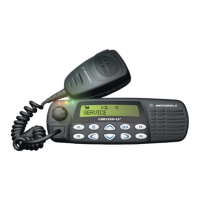2-16 Theory of Operation
2.3.6 Receive Signalling Circuits
Refer to Figure Figure 2-6 for the descriptions that follow.
DETAUDIO
DISCRIMINATOR AU
FROM RF SECTIO
(IF
IC)
DIO
N
2
I DATA FILTER
HSIO
AND DEEMPHASIS
LIMITER
DISC
ASFIC_CMP
U0221
Lj
FILTER
LIMITER
LSIO
PLEAP PLCAP2
~
~5
T T
19
18
Figure 2·6. Receive Signalling Paths
2.3.6.1 Sub-Audible Data (PLIDPL) and High Speed Data Decoder
82
,
7
MICRO
CONTROLLER
U0101
80
~
The ASFIC CMP (U0221) filters and limits all received data. The data enters the ASFIC CMP at
input DISC (U0221, pin 2). Inside U0221 the data is filtered according to data type (HS or LS), then
it is limited to a 0-5V digital level. The MDC and trunking high speed data appear at U0221, pin
19,
where it connects to the
1J
P
UO
1
01
, pin 82
The low speed limited data output (PL, DPL, and trunking LS) appears at U0221, pin 18, where it
connects to the
IJP
U0101, pin 80.
The low speed data
is
read by the
IJP
at twice the frequency
of
the sampling waveform; a latch
configuration in the ASFIC CMP stores one bit every clock cycle. The external capacitors C0236,
and C0244 set the low frequency pole for a zero crossings detector
in
the limiters for PL and HS
data. The hysteresis
of
these limiters
is
programmed based on the type
of
received data.
2.3.6.2 Alert
Tone
Circuits
When the software determines that it needs to give the operator
an
audible feedback for a good key
press, or for a bad key press, or radio status (trunked system busy, phone call, circuit failures), it
sends
an
alert tone to the speaker. It does so by sending SPI BUS data to U0221 which sets up the
audio path to the speaker for
alert tones. The alert tone itself can be generated in one
of
two ways:
internally by the ASFIC
CMP,
or externally using the
IJP
and the ASFIC
CMP.
The allowable internal alert tones are 304, 608, 911, and 1823Hz.
In
this case a code contained
within the
SPI BUS load to the ASFIC CMP sets up the path and determines the tone frequency, and
at what volume level to generate the tone. (It does not have
to
be related to the voice volume
setting).
For external alert tones, the
IJP
can generate any tone within the 100-3000Hz audio band. This is
accomplished
by
the
IJP
generating a square wave which enters the ASFIC CMP at U0221-19.
Inside the ASFIC CMP this signal is routed to the alert tone generator
The output
of
the generator is summed into the audio chain
just
after the
RX
audio de-emphasis
block. Inside U0221 the tone is amplified and filtered, then passed through the 8-bit digital volume
attenuator, which
is
typically loaded with a special value for alert tone audio. The tone exits at
U0221-41 and
is
routed to the audio
PA
like receive audio.

